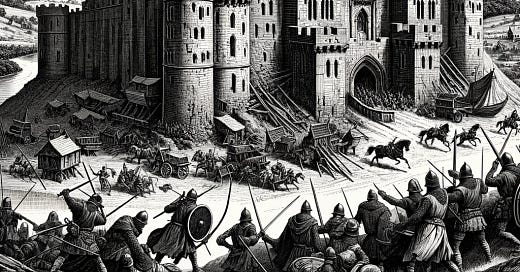The Siege of Henderland: A Cockburn Stronghold Under Attack
Nestled in the heart of the Scottish Borders, Henderland Castle stood as a testament to the power and influence of the Cockburn family. This formidable fortress, surrounded by the lush, rolling hills of Selkirkshire, became the epicenter of a dramatic and bloody conflict that echoed through the annals of Scottish history: the Siege of Henderland.
The Cockburn family, notable for their loyalty to the Scottish crown and their fierce independence, had long held Henderland as a crucial stronghold. The castle was not only a residence but also a strategic fortification, designed to withstand the many threats that plagued the borderlands. However, in the 16th century, this stronghold would face one of its greatest challenges.
Prelude to the Siege
The roots of the siege can be traced back to the turbulent period of the early 16th century, a time when Scotland was rife with political turmoil and clan rivalries. It was during this era that James V, King of Scots, sought to consolidate his power and bring order to the lawless border regions. The Cockburns, despite their loyalty, were seen as powerful local magnates who needed to be brought under the king’s direct control.
James V, known for his rigorous campaigns against the border reivers, launched an offensive to subdue the rebellious clans and secure the region. Henderland Castle, due to its strategic location and the influence of the Cockburns, became a prime target.
The Siege Begins
The siege commenced in 1530, with the royal forces surrounding Henderland Castle. The Cockburns, led by the formidable John Cockburn, were prepared to defend their ancestral home to the last man. As the royal troops advanced, the defenders of Henderland fortified their positions, readying themselves for the inevitable clash.
The first days of the siege were marked by intense skirmishes and heavy bombardment. The royal forces, equipped with the latest artillery, relentlessly pounded the castle walls. Despite the onslaught, the Cockburns held firm, their archers and soldiers repelling wave after wave of attackers.
A Family Tragedy
Amidst the chaos of battle, a tragic story unfolded. John Cockburn's wife, Marion Cockburn, became a symbol of the family’s resilience and bravery. According to local legend, Marion was captured during the siege and cruelly executed, her blood staining the walls of the castle she had valiantly defended. Her death became a rallying cry for the defenders, fueling their determination to hold out against the overwhelming odds.
The Fall of Henderland
Despite the Cockburns' valiant defense, the siege’s outcome was inevitable. The superior numbers and firepower of the royal forces gradually wore down the defenders. After days of relentless fighting, the walls of Henderland Castle were breached, and the royal troops stormed in.
John Cockburn was captured and taken to Edinburgh, where he faced the king’s justice. Henderland Castle, once a proud symbol of the Cockburn family’s strength, lay in ruins, its walls scarred by the fierce battle.
Legacy of the Siege
The Siege of Henderland left an indelible mark on the history of the Cockburn family. It symbolized the broader struggle between the Scottish crown and the powerful border clans, a conflict that shaped the course of Scotland's history. The bravery and resilience shown by the Cockburns during the siege became a part of the family's enduring legacy.
In the years that followed, the Cockburns rebuilt and continued to play a significant role in Scottish society. Henderland Castle, though never restored to its former glory, remains a poignant reminder of the family's storied past.
Conclusion
The Siege of Henderland stands as a testament to the tumultuous history of the Scottish Borders and the enduring spirit of the Cockburn family. It is a story of loyalty, bravery, and tragedy, echoing through the centuries as a powerful chapter in the saga of Scotland's noble families. As we remember the events that transpired at Henderland, we honor the legacy of those who fought and sacrificed for their home and heritage.





